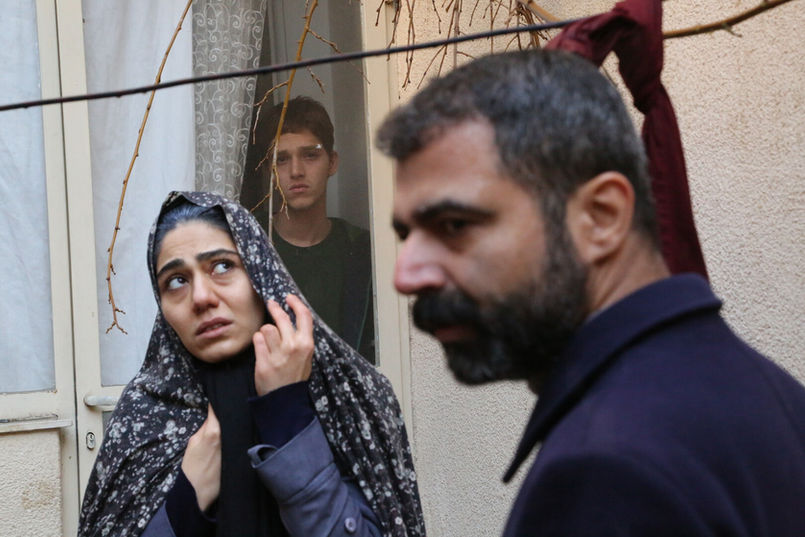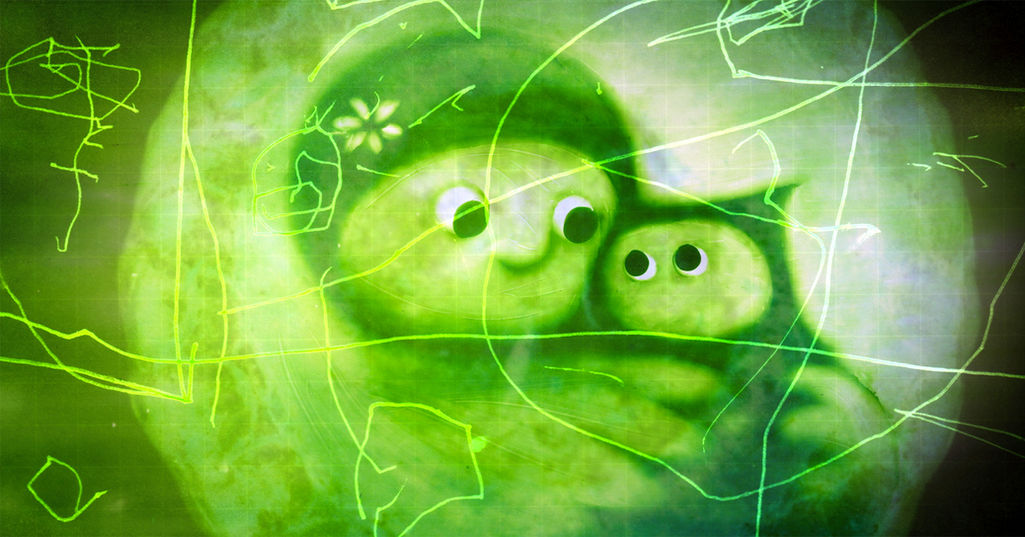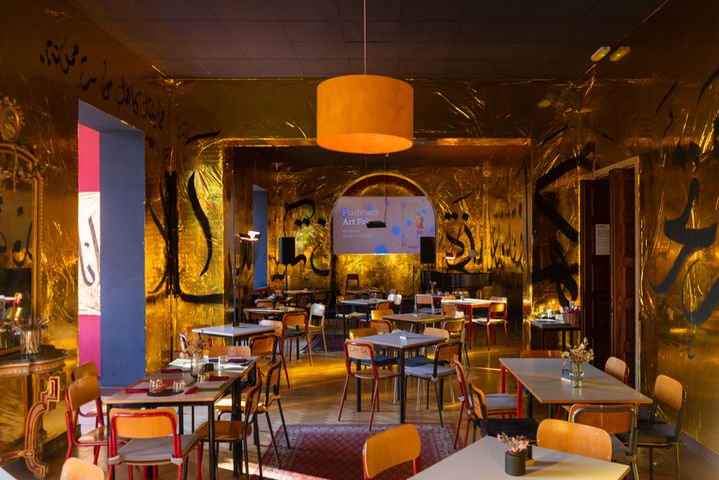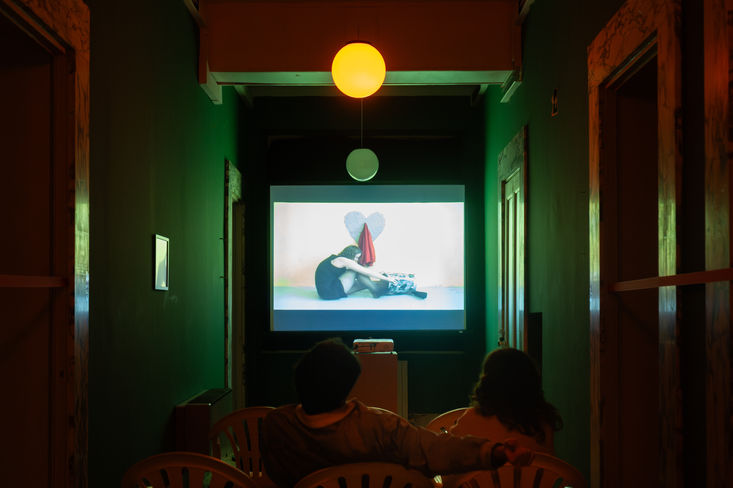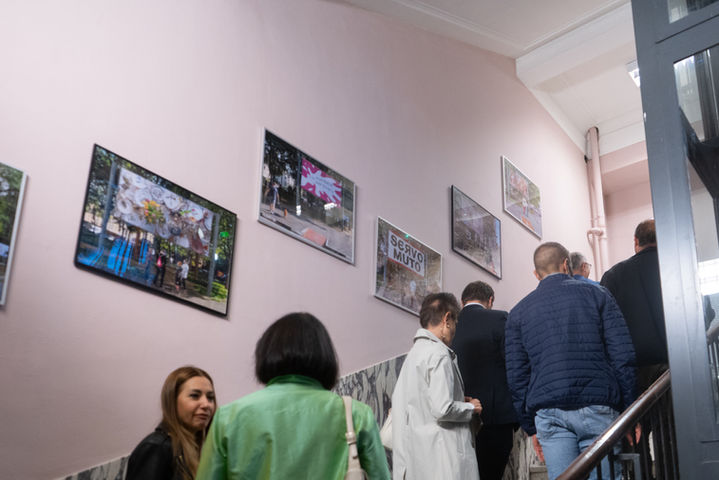Le Mostre
Mostre permanenti
Una vita migliore.
Frammenti di storie dell'Istituto per l'Infanzia
della Provincia ti Torino
un' opera di Alessandro Bulgini
in collaborazione con la Città Metropolitana di Torino
mostra in divenire
PAD. B - terzo piano
"Il progetto presentato a Flashback Habitat in corso Giovanni Lanza 75 a Torino, il cui titolo è Una Vita migliore. Frammenti di Storie dell'Istituto per l'Infanzia della Provincia di Torino non è per me da considerarsi mostra bensì Opera e atto d'amore".
A. Bulgini
La mostra Una vita migliore. Frammenti di storie dell’Istituto Provinciale per l’Infanzia della Provincia di Torino vuole ridare voce a quella moltitudine di mondi che si sono intrecciati nelle sale della struttura, ex brefotrofio di Torino, attraverso scorci di storie di alcuni dei protagonisti che, in prima persona, hanno vissuto quel luogo come i bambini, ora adulti, le tate, i dipendenti della struttura. La mostra, curata dall’artista e direttore artistico di Flashback Habitat Alessandro Bulgini, vuole essere un’opera collettiva, un’opera corale dove si intrecciano storia, emozioni, arte e vita. Una mostra che narra storie intime e personali, ma incredibilmente universali perché legate a concetti che ci toccano da vicino come la nascita, la famiglia, l’identità, attraverso frammenti originali, raccolti grazie alla collaborazione di chi c’era all’epoca, documenti recuperati negli archivi storici della Provincia di Torino e testimonianze dirette. La mostra vuole essere un affresco complesso, umano, sociale e soprattutto artistico, che valorizza le vite di ognuno rendendole opera d’arte, nello spirito e nella poetica di Flashback Habitat.
La mostra si sviluppa in otto stanze al piano terzo del Padiglione B di corso Lanza. Ogni stanza vuole essere un micromondo dove immergersi ed entrare nelle storie raccontate. Narrazioni personali e universali allo stesso tempo, opere collettive che parlano di vita. Ogni stanza si compone di ritratti audio-video dei “nativi” che rispondono alla domanda “Mi racconti?” e lo fanno di profilo: posizione che suggerisce un rivolgersi fuori, altrove o forse verso un altro io. I ritratti parlanti vengono accompagnati da componenti risalenti ad una mostra fotografica sul luogo allestita alla chiusura del brefotrofio. Infine, ogni stanza si arricchisce di una mappa-racconto con stratificazioni di significati grazie a fotografie e documenti di archivi pubblici e privati.
L’IPI, inaugurato nel 1958 dal Presidente Gronchi, ospitò ogni anno circa trecento bambini e bambine in attesa di adozione, spesso partoriti in corso Lanza 75, e poi dati in adozione, in genere prima dei tre anni. Oggi molti di quei bambini, diventati adulti, frequentano il luogo e le attività di Flashback Habitat, riconoscendo in corso Lanza le proprie origini, la loro prima casa, arricchendo di storie e di emozioni la nuova vita del luogo stesso.

mater
2023, Luce d'artista, Costellazione
Alessandro Bulgini
Insegna sagomata a lettere piane in alluminio verniciato,
illuminazione flex led - 10mx2,78m
Tetto del Pad. C
All’interno del progetto: Luci d’Artista, Costellazioni, nel 2023 è arrivata nella sede di Flashback Habitat l’opera di Alessandro Bulgini mater. Installata sul tetto della Palazzina C e visibile da Corso Vittorio Emanuele II fino alla stazione di Porta Nuova, l’opera è dedicata a coloro che sono nati più di quarant’anni fa nell’attuale sede di Flashback Habitat, l'ex brefotrofio della Provincia di Torino attivo fino agli anni Ottanta.
La luce si staglia sul tetto della villa più antica e più alta dell’ex Istituto, diventando un faro nel buio.
“Solitamente le opere sono dei doni, questa lo è ancor di più”
La storia di quest’opera parte dal momento in cui Alessandro Bulgini (artista e attuale direttore artistico di Flashback Habitat) è entrato nell’ex Istituto per l’Infanzia della Provincia di Torino in corso Giovanni Lanza 75, spazio affidato all’Associazione Flashback, in particolare nel momento in cui è venuto a conoscenza della sua storia. Una storia che nasce nel 1953 quando la Provincia decide di aprire l’Istituto per sopperire alle necessità determinate dalla grande immigrazione e dal gran numero di donne costrette a lasciare in affidamento i propri neonati. Questo spazio li accoglie per trent'anni poi, per il superamento di tale sistema, lo spazio viene chiuso. Venuto a conoscenza di questa storia, l’artista ha deciso di attivarsi nel riconoscere luogo di accoglienza a coloro che sono nati qui più di quarant'anni fa, dando loro uno spazio dove ritrovarsi. Fin dai primi contatti ha assunto il ruolo di guida all’interno delle quattro palazzine portandoli in ogni interstizio dell’articolato complesso e facendo ricalcare memoria e suggestioni a loro tanto care.
“Ripercorrendo gli spazi, alcuni di loro toccano le pareti alla ricerca della stratificazione pittorica che li ha visti presenti alla loro nascita. È per questo che, con lo scorrere del tempo, si è configurata in me l’idea che per assenza la madre era presente in questo luogo. Le mura diventano epidermide. È come se la madre avesse lasciato, nel poco tempo che è stata qui, la propria impronta. Per questo motivo semplice ma profondo ho pensato di dar loro una chiara indicazione che fosse visibile materialmente, un’opera che ridesse luce a un desiderio”.
Le parole di Alessandro Bulgini.

Vivarium [der. dal lat. Vivo]
è il progetto che abita lo spazio esterno di Flashback Habitat. La potente area verde di 9000 mq è trasformata in un vero e proprio parco d’arte in costante divenire. Habitat prende in affidamento le opere degli artisti, che danno vita a una fusione armonica con l'ambiente.
Passeggiando nel parco di Flashback Habitat si incontrano le Sedie nello spazio (1995) di Fabio Cascardi, installazione in acciaio e vernice antirombo inaugurata ad aprile 2023 e recentemente spostata nel punto più alto davanti al Padiglione B. Del 2023 è anche Mushroom Forest di Michel Vecchi, che utilizzando legni e tronchi recuperati nel parco, dà vita a colorati funghi di sorpresa, magia e curiosità. In occasione di Flashback Art Fair 2024, l’opera si arricchisce dei suoni che l’artista stesso ha registrato nel parco trasformandoli in colonna sonora naturale. Michel Vecchi è un artista valdostano che vive e lavora a Ibiza. Sempre del 2023 è il lavoro Tout se tient di Luisa Raffaelli, anch’esso realizzato rivivificando elementi già presenti nel parco. L’artista trasforma una struttura in tubi innocenti che funge da imbragatura in un elemento di protezione e sicurezza. Nel 2024, Carl Von Pfeil ha realizzato quattro sculture antropomorfe: Donna a braccia aperte, Uomo a vagare, Pulcino con i riccioli d’oro e Pittore con un occhio solo.
In occasione di Flashback Art Fair 2024, il parco ha preso in affidamento l'opera del direttore artistico di Flashback Habitat Alessandro Bulgini: Light of the Apocalypse, un’opera che intreccia memoria personale, storia e riflessione universale. Un grande faggio – morto, ma presente non solo come memoria – dipinto di rosso vivo e reso straordinario da luci e sfere luminose è il simbolo di un tempo nel quale siamo costantemente immersi.
Light of the Apocalypse incarna la tensione tra il sacro e il profano, tra rinascita e distruzione, invitando lo spettatore a riflettere sulla contemporaneità.
Da maggio 2025 è presente una nuova opera dell’artista Maurizio Taioli, intitolata Reality Fiction. La peculiare forma espressiva usata dall’artista - le sagome scultura da lui create - conduce lo spettatore a confrontarsi con una tematica attuale: la violenza umana analizzata sia da un punto di vista sociale che ontologico. L’oggetto di questa riflessione è svelato esplicitamente dal titolo, che si riferisce allo scontro tra realtà e immaginazione, tematica di grande attualità nel mondo della globalizzazione in cui i confini tra il reale, le immagini e i modelli imposti dalla fiction - in particolar modo dalla filmografia americana – sono sempre più labili e non permettono di distinguere cosa può essere definito con certezza “reale” o “immaginario”.

Flowers
2025
Fotografie di Enzo Obiso
Corridoi del Pad. B
Enzo Obiso, artista e fotografo (fondatore di PHOS – Centro per la Fotografia, realtà che vive e opera all’interno di Flashback Habitat) ci ha donato in occasione della fiera una serie di immagini che tramite l’utilizzo del lightbox ci accompagnano lungo i corridoi del Padiglione B.
Nel quotidiano e nella dimensione intima di questa installazione si riflette il processo stesso che ha trasformato gli edifici di corso Giovanni Lanza 75: da spazio istituzionale, un tempo dedicato alla tutela dei minori, a luogo aperto e condiviso, capace di accogliere e generare relazioni. Le fotografie di Obiso dialogano con le architetture del complesso, ne fanno affiorare la memoria e le stratificazioni, restituendo familiarità a un luogo che si svela attraverso la presenza e la vita delle persone che lo abitano.
I gigli marini, protagonisti ricorrenti delle immagini, fotografati tra il Vietnam e l’Italia, diventano segno di questa rinascita: le piante trasformano lo spazio in un luogo affettuoso, un ulteriore contributo alla costruzione di un habitat condiviso dove il quotidiano si intreccia alla relazione umana.
Mostre temporanee
mater Art Film Fest
la mostra
PAD. B - secondo piano
La prima edizione del mAFF - mater Art Film Fest è interamente dedicata all’audiovisivo nelle sue molteplici espressioni. La call di partecipazione al festival ha raccolto adesioni da artistə e registə provenienti da tutto il mondo. La giuria, composta da Diana Bagnoli, Gianluca De Serio, Christian Caliandro, Francesca Spada e Chiara Pellegrini, ha selezionato i 6 cortometraggi finalisti che sono presentati all’interno della mostra al Pad. B, pensata per mettere in discussione le modalità tradizionali di fruizione cinematografica. Trasposti dallo spazio della sala a quello espositivo, i corti diventano opere: oggetti visivi e temporali che si offrono allo sguardo non più secondo la linearità imposta dalla proiezio ne, ma come presenze installative. È un dispositivo che spinge il cinema oltre i suoi confini consueti, riformulando la relazione tra immagine, spettatore e spazio, e proponendo un nuovo modo di “abitare” il film. Durante i mesi di mostra la giuria popolare potrà votare il proprio corto preferito.
Al vincitore verrà assegnato il premio mater 2025. È il modo in cui Flashback interviene nello spazio deputato al cinema: offrire nuove chiavi di lettura, luoghi nei quali ciò che apparentemente distante si tocca e si contamina.
Neverland Gaza
di Alessandro Bulgini
dal 17 /04/2025, su prenotazione ogni giovedì
PAD. C - Zona chiusa ai visitatori, secondo piano
L'opera nasce come spazio di vicinanza e risonanza. Un'installazione raccolta, costruita a partire da oggetti quotidiani donati dalle persone – tappeti, sedie, luci, un fornelletto da campo – che diventano strumenti di relazione. L’opera mette in scena un rito immaginario, ispirato al gesto del tè condiviso tra le macerie di Gaza durante il Ramadan. In questo contesto sospeso e disarmato, l’arte si fa spazio abitabile, reale, profondamente nostro.
“L’opera non descrive, non commenta, non comunica” – scrive Christian Caliandro nel testo che accompagna il progetto – “non tratta un tema: lo vive, lo attraversa, ne fa esperienza. E quel qualcosa, a quel punto, non è più un tema. È la realtà.”
Ingresso gratuito
con prenotazione obbligatoria
(posti limitati)
ogni giovedì, h. 18:30
tel: +39 393 64 55 301
mail: info@flashback.to.it
Compassione
di Alexander Mostafa Fazari
a cura di Alessandro Bulgini
dal 23/10/2025
PAD. C - Il Circolino
Una nuova opera abita gli spazi del Circolino di Flashback: dove un tempo sorgeva la cappella dell'ex brefotrofio, oggi c'è il fulcro della convivialità, crocevia di popoli, culture e spiritualità diverse.
Al centro dell’installazione c’è un materiale simbolico e umile: la coperta termica d’emergenza, che si fa materia d’arte. Un sottile velo dorato, fragile e salvifico allo stesso tempo, diventa simbolo di un’umanità che resiste. La mano dell’artista Alexander Mostafa Fazari traccia con il segno calligrafico le parole di Gibran, Rumi e Ibn Arabi. Le lettere fluide richiamano la tradizione spirituale sufi, dove la scrittura stessa diventa preghiera e movimento dell’anima. Affiancati, materiale e parola creano spazi di empatia. Un invito a sentire la sofferenza dell’altro come propria, a ritornare alla compassione come origine, come strumento di legame.
Compassione non è, quindi, solo un’opera d’arte; è un invito: a ritrovarsi, ad ascoltare, a riflettere, a condividere un respiro comune di umanità. In un momento storico sempre più incerto come quello presente, tornare alla compassione come origine e radice del nostro sentire è un atto rivoluzionario.
BIO
Alexander Mostafa Fazari, artista egiziano con base a Torino, è conosciuto per le sue opere calligrafiche, in cui combina diversi mezzi espressivi per indagare le dinamiche sociali e valorizzare il potenziale culturale e artistico della città. Curioso e intraprendente, trae ispirazione dai viaggi e dall’ambiente che lo circonda, integrando calligrafia e tipografia multilingue con un forte approccio creativo. Le sue opere fanno parte di diverse collezioni private.
Butterfly
Rassegna di Videoarte
a cura di Rebecca Russo
in collaborazione con Videoinsight® Foundation
dal 25/09/2025 al 29/03/2026
Pad. C - area cinema
Flashback esplora da sempre ciò che si nasconde sotto la superficie, abbraccia le marginalità ed è capace di cogliere negli “altrove” fisici e mentali del quotidiano quel terreno fertile, trasformativo e rivoluzionario della pratica artistica. Con lo stesso spirito, la missione della Fondazione Videoinsight® è quella di utilizzare l’arte come strumento di cura, introducendola in diversi contesti sociali o spazi istituzionalizzati della salute al fine di valorizzarne il potere rigenerativo e di crescita nelle persone fragili. È così che la mostra Butterfly si integra nella storia importante e complessa di Flashback Habitat, ex brefotrofio di Torino e luogo di accoglienza di madri e bambini dagli anni ‘50 agli anni ‘80, oggi diventato ecosistema aperto, casa condivisa delle persone e delle culture contemporanee.
Ci racconta Rebecca Russo: “La farfalla è uno dei simboli più potenti e universali di trasformazione, rinascita e bellezza interiore. Il suo ciclo di vita – dall’uovo alla larva, poi alla crisalide e infine alla creatura alata – rappresenta un processo profondo di cambiamento e crescita. È associata alla libertà, alla leggerezza dell’essere, ma anche alla fragilità e all’impermanenza, poiché la sua esistenza è breve, ma intensa, come certi momenti preziosi della vita. La farfalla invita a lasciare andare il passato, ad accettare il cambiamento e ad avere il coraggio di evolvere. Ricorda che anche ciò che appare immobile o oscuro (come la crisalide) può contenere il seme di qualcosa di meraviglioso.Le ferite umane, per quanto dolorose, possono diventare ali per spiccare voli di emancipazione, di consapevolezza, varchi attraverso cui entra la luce. Ogni dolore vissuto, ogni caduta, ogni perdita lascia un segno, che non è soltanto sofferenza: è anche memoria, esperienza, verità. I limiti, le perdite, causano crepe, nelle quali si nasconde, si rivela la possibilità di trasformazione. Le fragilità provocano autenticità, forza e luminosità. Il fallimento attraversato con consapevolezza può diventare compassione, profondità. arte. Le cicatrici raccontano una storia: non sono un difetto, ma una forma di bellezza, più vera. Le vulnerabilità possono trasformarsi in risorse: diventando sensibilità, capacità di comprendere gli altri, desiderio di autenticità. La farfalla è poesia in movimento, messaggera silenziosa di speranza, trasformazione e nuova vita”.
Artist* delle opere di videoarte tratte dalla Collezione Videoinsight®
Janet Biggs, Can't find my way home, 2015, 09’ 45’’
Maurizio Camerani, Sub, 1994, 06’ 06’’
Emilia Faro, The Prince's metamorphosis, 2010, 03’ 29’’
Michael Fliri, Getting too old to die young, 2008, 00’ 47’’
Kate Gilmore, My love is an anchor, 2004, 07’ 06’’
Goldiechiari, 1969, 2010, 04’ 23’’
Vlatka Horvat, Restless, 2010, 08’ 18’’
Polina Kanis, Eggs, 2010, 17’ 28’’
Ali Kazma, Dance Company, 2009, 10’ 17’’
Edson Luli, What is man, 2014, 06’ 55’’
Marcos Lutyens, The subjective self: twinnapse, 2013, 01’ 40’’
Ursula Mayer, The crystal gaze, 2007, 14’ 39’’
Marcello Maloberti, Blitz, 2012, 07’58’’
Masbedo, Glimà, 2008, 18’ 26’’
Hans Op De Beeck, Parade, 2012, 11’ 17’’
Fabrizio Passarella, Il Giardino Rabescato, 2013 - 2016, 15’ 48’’
Fabrizio Passarella, Dreams, 2022 - 2025, 17’ 30’’
Cheryl Pope, Stacks, 2010, 10’ 05’’
Sissi, Daniela ha perso il treno, 1999, 01’ 30’’
Michele Tombolini, Indelible marks, 2016, 07’ 13’’
Ulla Von Brandenburg, Singspiel, 2009, 06’ 39’’.
Gaza Opera Viva / Opera Viva, il Manifesto - Stargate to Gaza
di Alessandro Bulgini
a cura di Christian Caliandro
PAD. B - piano terra
Il progetto artistico Opera Viva di Alessandro Bulgini ha sempre avuto come obiettivo principale quello di illuminare zone rimosse, marginali, sommerse dell’esistenza e della realtà quotidiana – e di farlo attraverso la pura presenza, l’azione discreta dell’artista.
In questo senso, la “divisa” rossa diventa un segnale, un indicatore: sta per una connessione possibile, un collegamento tenue ma essenziale. L’autore diventa così – come scriveva Giulio Paolini – latore dell’opera: e l’opera stessa è il contesto, o meglio, la relazione con il contesto. Osservare il corpo di Bulgini e il segno di questa maglietta rossa che si posiziona nei centri delle città (Milano, Roma, Torino) e tra gli stand delle fiere d’arte contemporanea (Art Basel, miart) stabilisce immediatamente una connessione, un rapporto, che è al tempo stesso un distacco, una distanza: quella che separa un mondo turistico, creativo ed economico che sembra voler proseguire le proprie faccende come se nulla fosse, che sembra cioè voler far finta di niente a tutti i costi, e la traccia, il ricordo, il sintomo di qualcosa che è andato storto, terribilmente storto. Di qualcosa che è fuori posto, e lo sarà sempre. Qualcosa che, come ogni rimosso - e come la barca a vela con la bandiera in cima all’albero che svetta in alto sulla parete della prima sala - tornerà ancora e ancora e ancora…
Opera Viva Barriera di Milano
Il Manifesto
2015 - 2024
PAD. B - Scale
Una raccolta di immagini delle edizioni del progetto sul territorio Opera Viva Barriera di Milano - Il Manifesto
a cura di Alessandro Bulgini, dal 2015 al 2024.
Unconscious Elevation
Carl von Pfeil
installazione Audio
Pad. B - ascensorensta
Unconscious elevation (61’22”) è un’installazione sonora radicata nella dimensione dell’ascesa interiore. Prendendo il titolo dalla “posizione anti-shock”, suggerisce l’idea di un ritorno dell’energia vitale verso il centro del corpo e della mente. L’opera si struttura come un’unica esperienza immersiva: una traccia sonora ambient, poetica e progressiva, che conduce chi ascolta verso soglie interiori.
BIO
Carl Pfeil nasce in Alto Adige, opera e vive tra Torino e Bolzano. Formatosi anche nel campo della fotografia analogica e del cinema (tra cui studi come direttore della fotografia, anche all’estero), sviluppa una poetica che si pone al confine tra immagine, suono e esperienza corporea. Negli ultimi anni ha realizzato opere site-specific e installazioni immersive basate su processi meditativi e sensoriali, capaci di attivare relazioni tra spazio e memoria, percezione e silenzio.











